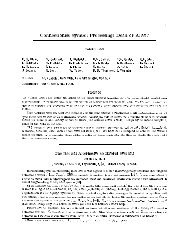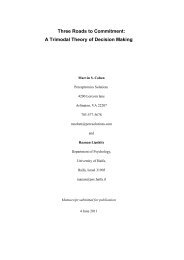Three Roads to Commitment: A Trimodal Theory of Decision Making
Three Roads to Commitment: A Trimodal Theory of Decision Making
Three Roads to Commitment: A Trimodal Theory of Decision Making
You also want an ePaper? Increase the reach of your titles
YUMPU automatically turns print PDFs into web optimized ePapers that Google loves.
<strong>Three</strong> <strong>Roads</strong> <strong>to</strong> <strong>Commitment</strong>: A <strong>Trimodal</strong> <strong>Theory</strong> <strong>of</strong> <strong>Decision</strong> <strong>Making</strong> 13<br />
A second type <strong>of</strong> rebuttal is relevant when multiple practices (i.e., distinct Warrants) are applicable <strong>to</strong> the same<br />
problem, are deemed appropriate by matching at the same or different times, and produce conflicting Claims. For<br />
example, satisficing (Simon, 1987) is a hybrid <strong>of</strong> modes: Appropriate actions are generated by matching and then<br />
reassessed by the desirability <strong>of</strong> their consequences. The last row <strong>of</strong> Table 1 shows that rebuttals can be found <strong>to</strong><br />
Claims <strong>of</strong> any decision making mode if reassessed from the perspective <strong>of</strong> any other. In principle, such rebuttals<br />
might generate a series <strong>of</strong> challenges and defenses that pit competing warrants and backing against one another.<br />
When they apply in the same contexts, different modes may generate normatively clashing results just as different<br />
practices do. 5 In the next three sections, we provide some perspective on these clashes, for two reasons: First,<br />
because they have important implications for the prescriptive use <strong>of</strong> different modes in training and decision aiding;<br />
and second, because they highlight the distinctiveness <strong>of</strong> the three modes as forms <strong>of</strong> argument.<br />
The Primacy <strong>of</strong> Matching<br />
Choice and reassessment are practices whose applicability is limited by a web <strong>of</strong> cultural obligations and rights<br />
and individual differences, and which may fit some situations badly (Etzioni, 1988). Choice depends on cultural<br />
attitudes or personal policies that license calculation <strong>of</strong> outcomes and deliberate weighing <strong>of</strong> trade<strong>of</strong>fs.<br />
Reassessment depends on cultural attitudes or personal policies that license critical reflection, dissent, au<strong>to</strong>nomy,<br />
change, or progress. Societies differ in the leeway they afford individuals <strong>to</strong> negotiate their roles and relationships or<br />
choose their own goals and tactics (Douglas & Wildavsky,1982; Douglas, 1999; Thompson, Ellis, & Wildavsky,<br />
1990). Matching itself determines when it is permissible <strong>to</strong> engage in choice and reassessment in lieu <strong>of</strong> the default,<br />
which is always continued matching. Whenever choice and reassessment processes occur, they are implicitly<br />
embedded within prior processes <strong>of</strong> matching. 6<br />
decision mode or does not. Ethically committed participants should be more likely <strong>to</strong> reassess and reject their initial<br />
commitment based on ethical counter-evidence; instrumentally committed participants should be more likely <strong>to</strong><br />
reassess and reject their initial commitment based on instrumentalist counter-evidence; reassessment oriented<br />
participants should respond <strong>to</strong> information about testing and performance. Similarly, decision aid users will actively<br />
reject decision aid recommendations that are generated and justified by an inappropriate decision making mode.<br />
5 A number <strong>of</strong> studies have examined how people resolve conflicts among ethical principles, or between ethical<br />
principles and instrumentalist incentives. Material inducements <strong>to</strong> abandon an ethical or identity-based decision may<br />
result in anger or outrage (Ginges, Atran, Medin, & Shikaki, 2007), while conflicts among ethical principles is<br />
experienced as emotionally stressful and difficult (Hanselmann & Tanner, 2008).<br />
6 TDM implies that personal and cultural values might influence decision making mode in situations where more<br />
than one might apply. For example, drawing speculatively on the elements <strong>of</strong> Schwartz’ (1992; Schwartz & Bilsky,<br />
1987a,b) value model, matching might be more dominant for persons or cultures that score high on security,




